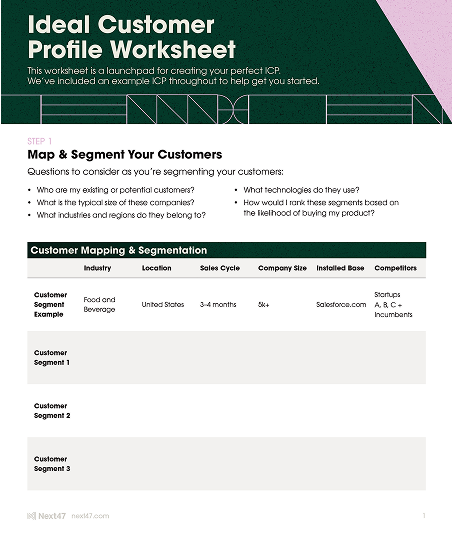Are you an early stage founder trying to unlock your market potential? Check out more insights from the Next47 team, leading sales experts, and founders in our Enterprise Sales Playbook.
As an early stage founder, it’s normal to feel like the clock immediately starts ticking when your funding round closes. With an endless to-do list forming, finding the right place to start on go-to-market (GTM) can be daunting.
While it may be tempting to begin hiring salespeople and pursuing customers, one crucial task needs to be accomplished first: defining your Ideal Customer Profile (ICP).
In this post, we cover everything you need to know to master your ICP— the foundation of any go-to-market strategy.
We’ll cover:
An ICP success story
How to map your perfect ICP
A step-by-step guide to getting your ICP started
What Does A Good ICP Look Like?
ICP is the core building block of your GTM strategy. It will influence all aspects of your sales organization. The ICP will impact things like who to hire, org structure, sales methodology, marketing strategy, and even the tools that you’ll use. It takes time and focus. We’ve seen companies with a perfect ICP and others that need to pivot, and it’s given us a clear perspective on what works and what doesn’t.
A Brief Brief
A common mistake in defining ICP is going too broad. It is extremely important to stay focused on a core market. A good example of a company staying focused is Markforged, which develops cloud-based industrial 3D printers that power thousands of top manufacturers and brands across the globe. The company had a very successful ICP and subsequent GTM execution.

In the vast universe of parts that can be 3D printed, Markforged Founder & CEO Greg Mark quickly realized the opportunity of the automotive industry in North America. He focused specifically on the need for parts that support industrial processes, such as fixtures, robot grips, and tooling—parts that are essential for the industrial process and can make a production line stop. By creating portable 3D printers designed for the factory floor, customers had timely access to parts, which enabled them to sidestep the whole cycle of ordering from a third party. Markforged’s narrow focus made its initial go-to-market push incredibly successful and brought the company marquee customers like Nissan, Dunlop, and Dana Corp.
The best way to set yourself up for GTM success is through your ICP, but there’s a lot that can go wrong during your refining process. Next, we’ll cover how to ensure you’re ready from the start.
Determining the Perfect ICP
The goal of mapping your ICP is to get to know your potential customers as best as you can. This can only happen through extensive research, and your data collection needs to start now.
We’ve broken down the mapping process to get you started:
1. Identifying a Pain Point Isn’t Enough
You must understand your customer’s problem down to its core. Find the root cause of the pain and examine it. Ask yourself:
What is it?
Why does it exist?
How are customers solving that problem today?
Is it a problem worth fixing and what is the benefit of solving it?
What consequences arise if the issue is left unaddressed?
Am I the one to fix it and why am I uniquely qualified?
Are there other legacy solutions in the marketplace or am I creating a new solution?
Finding the core metrics that surround or support the pain point will help you be more thoughtful and deliberate about bringing your product to market and demonstrating its value to your customers. Once this key understanding is developed, you can identify which customer segments to target.
2. Customer Segmentation Thesis
Armed with answers to the questions above, and supported by the metrics you’ve gathered, start looking for patterns. Which industries, markets, or verticals are facing the pain your solution is addressing? What size company is the product resonating with? What stage of company?
Break your customers down into distinct groups. Choose whichever criteria are not only relevant but also that which you’re best positioned to support. Segmenting by industry, interests, company size, stage, geography, and behavior are good places to start.
3. Data-Driven Validation
Validate your thesis by talking to potential customers and reaching out to your network. Distribute surveys, look into your website and social analytics, examine sales data, and ask for feedback from your existing customers. Analyzing current and potential customer behavior from various sources will arm you with what you need to move to the next stage.
4. Understanding Buyer Personas & Org Structure
With clear customer segments in mind, your next step is to create distinct personas for each potential buyer and influencer. Build a story around each by asking:
What is their title?
What are the key industry challenges with which they are faced?
Where do they learn and gather information?
How do they buy: direct or value-added resellers?
What are they passionate about? Why?
What pain points are coming up at work?
How do they communicate?
You want specific buyer personas, so ask specific questions.
Understanding the org structure and buying process is also critical. Is your persona the influencer, the decision maker, the owner of the budget, the key executive stakeholder, or all of the above?
Furthermore, you’ll want to understand the language that your persona speaks and ensure that the way you communicate your product and its benefits is representative of the buyer.
5. The Map Itself
Each buyer persona has a different way they’ll interact with your solution, and your next step is to map that. Create a customer journey for each persona. Because every persona has unique needs and communication styles, each one will have unique touchpoints, marketing channels, and decision-making moments. The better you understand your buyer personas and the core metrics of the pain you’re addressing, the easier this will be.
Mapping by role can also help you understand the buying and approval process. Ask the following questions:
What business outcomes do a CXO, VP, Director, or other important influencer expect?
What are the bottom-line financial payback metrics and how fast can your customer expect to receive a return on their investment?
Are there top-line metrics you can measure, time to market, or competitive market advantages?
The process of understanding the answers to these questions will help address objections throughout the buying cycle, set expectations for delivery, and measure success for your project. Add-ons and cross-sales will be well-defined along with a solid basis for referenceability.
6. Competitor & Tech Stack Research
It’s important to understand the ecosystem and landscape, and where you fit into the techstack. Know your competitors and potential partners, and keep tabs on their customer base and target audience. If you have overlapping segments—great! Figure out which untapped opportunities those customers have and go after them. This may lead you to edit your buyer personas or find a use case others have been missing.
From a competitive standpoint, this will help you design battle cards and handle objections during future conversations. From a techstack standpoint, this will help define your partner strategy along with engineering roadmaps for integrations and continued business process optimization.
7. Refine, Refine, Refine
As you’re crafting your ICP and testing it in practice, roadblocks may arise. Be wary of spending too much time refining a certain area, as it may be best to simply abandon a segment or use case. Through this process, you may find a demographic that’s been entirely ignored or a segment that’s too saturated. When you discover these key insights, adjust your ICP accordingly.
Repeat this process as your company grows. The accuracy and relevance of your ICP at the seed stage may not be the same at Series A. Don’t be afraid to edit and pivot.
Conclusion
Here at Next47, we know how critical it is to get your ICP right. We’ll be continuing this series to help you solidify your GTM strategy—one step at a time.

Fill Out This Form To Create Your ICP
Now that you have the process down—you’re ready to get started. Fill out this form to download a template and brainstorm your ICP. In addition to what we shared above, you’ll find some guiding questions to get your process moving.


